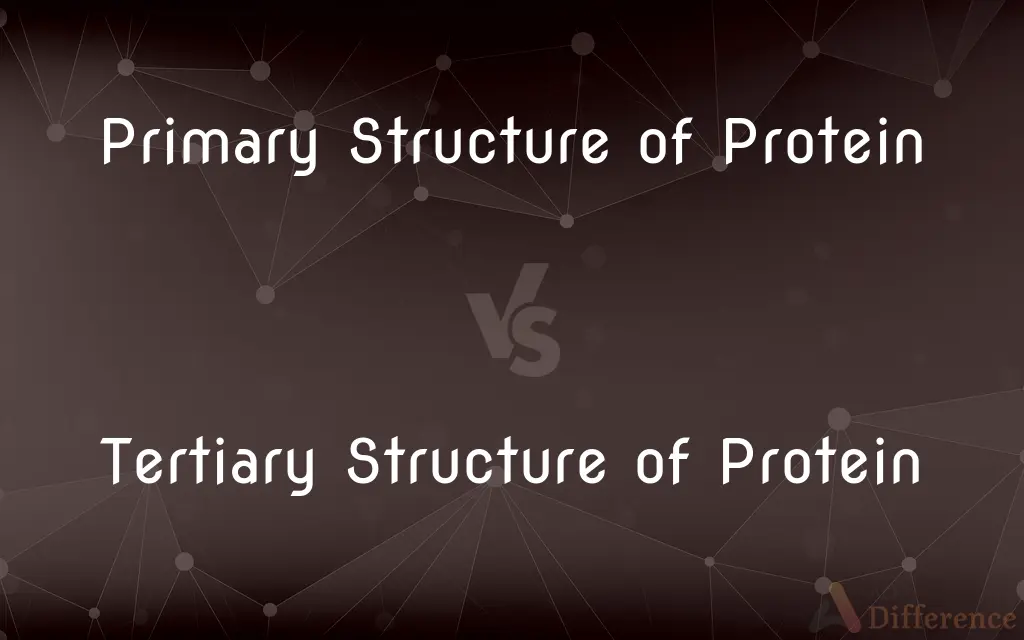Primary Structure of Protein vs. Tertiary Structure of Protein — What's the Difference?
Edited by Tayyaba Rehman — By Maham Liaqat — Published on February 24, 2024
The primary structure of a protein is its linear sequence of amino acids, crucial for determining the protein's function. The tertiary structure represents the protein's three-dimensional shape, formed by the folding of the secondary structures.

Difference Between Primary Structure of Protein and Tertiary Structure of Protein
Table of Contents
ADVERTISEMENT
Key Differences
The primary structure is the foundational level of protein structure, consisting of a specific sequence of amino acids linked by peptide bonds. The tertiary structure is the full three-dimensional conformation of a protein, resulting from the complex folding of its secondary structural elements (α-helices and β-pleated sheets) into a compact shape.
The sequence in primary structure is directly encoded by the organism's genes and dictates not only the protein's higher-level structures but also its biological function. While the folding of tertiary structure is driven by various forces, including hydrophobic interactions, hydrogen bonds, ionic interactions, and disulfide bridges between cysteine residues.
The transition from primary to tertiary structure involves the protein's journey through its secondary structures, folding into a specific three-dimensional shape that is energetically favorable and functionally active. This process is guided by the primary structure's sequence, which inherently contains the information required for the protein to achieve its final conformation through intramolecular interactions.
The interplay between primary and tertiary structures is fundamental to understanding protein folding diseases, where misfolding or aggregation of proteins can lead to conditions like Alzheimer's disease and cystic fibrosis. Moreover, the study of these structures has significant implications in biotechnology and medicine, including drug design, where understanding the precise arrangement of amino acids in a protein's active site can inform the development of therapeutic molecules.
Comparison Chart
Definition
Linear sequence of amino acids
Three-dimensional folding of the protein
ADVERTISEMENT
Components
Amino acids linked by peptide bonds
α-helices, β-pleated sheets, random coils
Stabilizing Forces
Peptide bonds between amino acids
Hydrophobic interactions, hydrogen bonds, ionic interactions, disulfide bridges
Dependency
Determined by genetic sequence
Determined by the primary structure
Determines
The potential for protein folding and function
The protein's functional conformation
Impact of Alterations
Can change the protein's folding and function
Misfolding can lead to loss of function or diseases
Examples
Sequence of insulin, hemoglobin
Enzymatic active sites, antibody binding domains
Compare with Definitions
Primary Structure of Protein
The unique sequence of amino acids in a polypeptide chain.
The primary structure of insulin dictates its ability to regulate blood sugar levels.
Tertiary Structure of Protein
Influenced by the protein's environment.
Changes in pH can disrupt the tertiary structure, affecting the protein's activity.
Primary Structure of Protein
Encoded directly by genes.
Mutations in the BRCA1 gene alter the primary structure of its protein product, affecting breast cancer susceptibility.
Tertiary Structure of Protein
Crucial for protein's biological function.
Alterations in the tertiary structure can render a protein nonfunctional.
Primary Structure of Protein
Linear arrangement of residues.
The primary structure is like a string of beads, each representing an amino acid.
Tertiary Structure of Protein
Formed by the folding of secondary structures.
Myoglobin's tertiary structure allows it to store and release oxygen in muscle cells.
Primary Structure of Protein
Determined by genetic information.
A mutation in the gene alters the primary structure of hemoglobin, leading to sickle cell anemia.
Tertiary Structure of Protein
Stabilized by various interactions among side chains.
The hydrophobic core of a globular protein stabilizes its tertiary structure.
Primary Structure of Protein
Foundation for higher-order structures.
The primary structure of collagen includes a repeat of glycine-proline-X, essential for its triple helix formation.
Tertiary Structure of Protein
The three-dimensional shape of a protein.
The tertiary structure of an enzyme determines its substrate specificity.
Common Curiosities
How does the primary structure influence the tertiary structure?
The sequence of amino acids (primary structure) dictates how secondary structures will fold and interact, ultimately determining the protein's tertiary conformation.
Can a protein have multiple tertiary structures?
While a protein typically folds into a single stable tertiary structure under physiological conditions, some proteins can adopt multiple conformations, which is crucial for their function, such as in the case of prions.
What happens if there's a mistake in the primary structure?
A mistake or mutation in the primary structure can lead to improper folding into the tertiary structure, potentially resulting in loss of function or disease.
Why is the tertiary structure important for drug design?
Understanding the tertiary structure of target proteins allows for the design of molecules that precisely fit into active or binding sites, leading to the development of more effective and specific drugs.
Can changes in the tertiary structure be reversible?
Yes, some changes in tertiary structure, such as those induced by changes in pH or temperature, can be reversible. However, severe denaturation or misfolding may lead to irreversible changes.
How are proteins' tertiary structures determined experimentally?
Techniques like X-ray crystallography, nuclear magnetic resonance (NMR) spectroscopy, and cryo-electron microscopy are used to elucidate the tertiary structure of proteins.
How do chaperone proteins relate to tertiary structure?
Chaperone proteins assist in the proper folding of polypeptides into their tertiary structure, preventing misfolding and aggregation that could lead to cellular dysfunction.
How do molecular chaperones affect the formation of tertiary structures?
Molecular chaperones assist in the proper folding of polypeptides into their functional tertiary structure, preventing incorrect folding and aggregation by temporarily shielding hydrophobic areas.
What role does the tertiary structure play in enzyme specificity?
The tertiary structure creates a unique three-dimensional active site, where specific substrates can bind and undergo catalysis, determining the enzyme's specificity.
How does the tertiary structure facilitate protein-protein interactions?
The three-dimensional shape of the tertiary structure presents specific surface areas and binding sites that enable selective interaction with other proteins, essential for signaling pathways and cellular functions.
How does the environment inside a cell influence protein tertiary structure?
The cellular environment, including pH, ionic strength, and the presence of chaperones, influences the folding and stability of the protein's tertiary structure.
Are there diseases associated with defects in tertiary structure?
Yes, diseases such as Alzheimer's, Parkinson's, and cystic fibrosis are associated with defects in protein folding, leading to improper tertiary structure and function.
Can the tertiary structure of a protein change without altering the primary structure?
Yes, post-translational modifications (such as phosphorylation) or interactions with other molecules can induce conformational changes in the tertiary structure without altering the primary amino acid sequence.
What is the significance of disulfide bonds in tertiary structure?
Disulfide bonds, formed between cysteine residues, provide additional stability to the tertiary structure by covalently linking different parts of the protein chain, crucial for the structural integrity of extracellular proteins.
What techniques are used to predict tertiary structure from primary structure?
Computational methods, including homology modeling and ab initio modeling, predict tertiary structure based on known structures of similar sequences or on physical principles governing protein folding.
Share Your Discovery

Previous Comparison
Cristae vs. Cisternae
Next Comparison
Monohydrate Creatine vs. Micronized CreatineAuthor Spotlight
Written by
Maham LiaqatEdited by
Tayyaba RehmanTayyaba Rehman is a distinguished writer, currently serving as a primary contributor to askdifference.com. As a researcher in semantics and etymology, Tayyaba's passion for the complexity of languages and their distinctions has found a perfect home on the platform. Tayyaba delves into the intricacies of language, distinguishing between commonly confused words and phrases, thereby providing clarity for readers worldwide.
















































